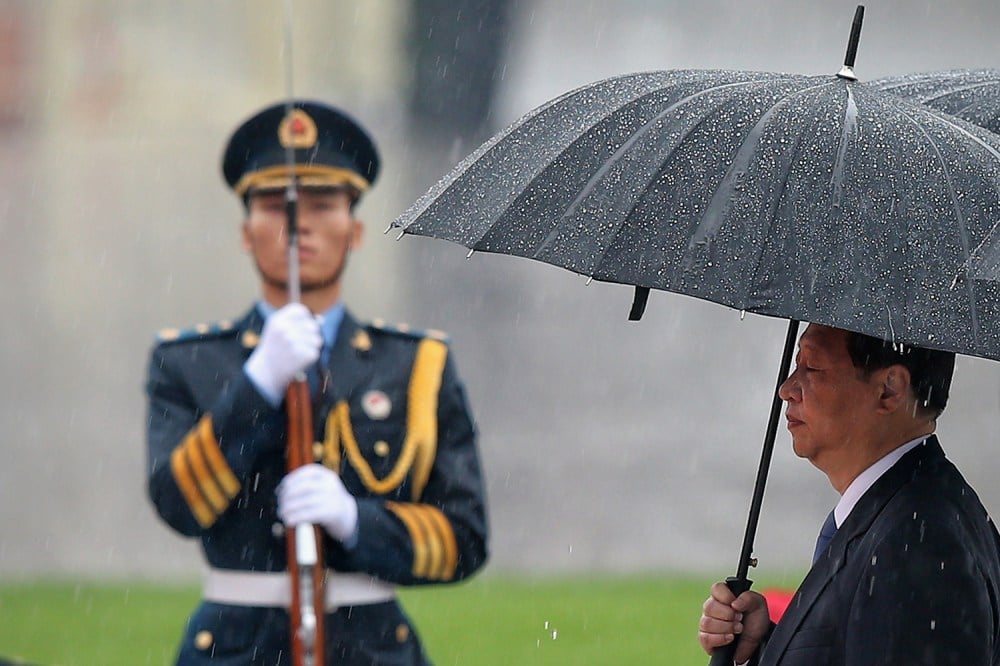Why China Is Not a Superpower How the United States, China, and the former Soviet Union stack up.
View attachment 919904
China’s growing power is the single most influential driver of geopolitical change today. Notwithstanding Russia’s ongoing war in Ukraine, the United States has clearly identified China as its number one challenge. In June 2022, for the first time ever, NATO included China in its Strategic Concept, signaling a radical shift in the bloc’s security outlook.
But how mighty is China really? Measuring and comparing power between nations and across time is an imprecise exercise at best. Nonetheless, we can gain valuable information about China’s current power position if we compare it to the contemporary United States and Cold War-era Soviet Union—and consider three important concepts: polarity, hegemony, and the original definition of a superpower.
Such a comparison reveals that the United States is a pole, regional hegemon, and superpower. The Soviet Union was a pole and a superpower—but did not have regional hegemony. And although China is a pole in what is now a bipolar U.S.-China system, it is neither a regional hegemon nor a superpower. While these categorizations might read like abstract nuances in a scholarly debate, they actually have major, concrete implications for strategy and policy in the 21st century.
Polarity is simply the number of great powers in the international system. The most common method to determine which powers count as great is to look at key indicators: population, territorial size, resource endowment, economic capability, military strength, political stability, and policy competence. Using these seven indicators, we can see the international system now has a distinct bipolar power structure, with China and the United States as the two poles—similar to the U.S.-Soviet rivalry during the Cold War.
In terms of economic power, the current system is actually even more perfectly bipolar than during the Cold War, with China’s aggregated economic wealth almost equaling that of the United States. The
Soviet economy, on the other hand, never accounted for more than 50 percent of the U.S. economy. With regard to military power, however, the current international system is less perfectly bipolar than it was during the Cold War, with a larger gap in military might between Washington and Beijing now than Washington and Moscow then. The major reason for the larger gap is that China spends a smaller share of its GDP on defense than the Soviet Union did during the Cold War.
According to the theory of structural realism, the number of poles in a power structure informs great power behavior and international order in unique ways. A bipolar power structure is expected to drive the two poles toward an intensive, all-encompassing rivalry and create a distinct two-bloc divide between the two rivals and their respective allies—a divide that extends to military, economic, and other matters. This was the case during the U.S.-Soviet rivalry, and we see signs of a similar development today. (The debate even asks whether the U.S.-China rivalry will turn into a new cold war.)
Polarity alone, however, does not provide us with the full picture of China’s might. Unlike polarity, which derives from power and size, the concepts of hegemony and superpower are geopolitical concepts that provide us with additional information about the reach and limits of China’s influence.
“Superpower” was coined as a concept by the American international relations scholar William T. R. Fox in his book
The Superpowers, published in 1944. With the United States and China the two dominant states in a bipolar power structure, it is common to refer to both countries as superpowers. Needless to say, only poles in the international system can be superpowers—but being a pole is not the only requirement for being a superpower. If one goes by Fox’s original definition, China is not a superpower.
Fox divided great powers into two categories: superpowers and regional powers. According to Fox, superpowers have global influence and the capability to throw their armed forces into any major theater of war dictated by grand strategy. Regional powers, on the other hand, may enjoy the formal and ceremonial prestige of great power status, but their influence is great in only a single theater of power conflict. Fox stressed that only a power with a huge territorial range can be a power in more than one part of the world. In 1944, Fox still defined Britain as a superpower due to its Commonwealth and empire—and its ability to project power in all the main theaters of the world, including with large numbers of colonial troops. Yet after World War II, it soon became obvious that Britain was no longer either a pole or a superpower.
The United States is undoubtedly a superpower, with a world-wide network of alliance agreements and overseas bases enabling it to deploy and move forces rapidly between various theaters. The Soviet Union, too, was a superpower. Although Moscow was never able to establish a world-wide network of military bases on a similar scale as Washington, its position in the Eurasian heartland allowed it to influence the strategic theaters in Europe, the Middle East, South Asia, and East Asia. Toward the end of the Cold War, the Soviet Union also had a navy with global reach.
China, however, is only a regional power. It wields global economic power and influence, but the geographic reach of its military is largely limited to the Asian and Indo-Pacific theaters. From its position in the East Asian rimland, China has more limited geographic reach into the Eurasian continent than the Cold War-era Soviet Union did—and less access to the high seas than either the United States or the Soviet Union. The United States’ blessed geographic position gives it direct and unhindered access to the Atlantic, Pacific, and Arctic oceans. Although the Soviet Union’s access to the high seas was more restricted than that of the United States, it still had direct access from its homeland to the Pacific and Arctic oceans, as well as almost-but-not-quite direct access to the Atlantic Ocean. China only borders the Pacific Ocean—and is largely hemmed in by major island chains it does not control.
Naturally, China’s nuclear, space, and cyber capabilities all have worldwide reach. China is modernizing and expanding its nuclear force as well as its nuclear delivery platforms. Moreover, with nearly 600 satellites in orbit—of which 229 are intelligence, surveillance, and reconnaissance satellites—China has the world’s second largest fleet of satellites after the United States. Chinese cyber capabilities can wreak havoc in every corner of the world. And these days,
balloons should perhaps also be added to the picture as a potent capability with global reach.
Nevertheless, the geographic reach of these technologies is insufficient to strongly influence strategic theaters beyond Asia. Even in an age of space and cyber warfare, coercive diplomacy is more effective when troops can be physically deployed to a border or shore. Gunboat diplomacy still requires boats, and airplanes still need airfields to operate in far-flung regions. In other words, geography makes China even more dependent than the United States and former Soviet Union on overseas bases and willing allies to move its armed forces beyond its home region. China has almost none of either.
China currently has only one overseas base—its naval facility in Djibouti staffed with 400 Chinese marines. While the U.S. Navy sails the world’s oceans on a daily basis, the Chinese navy only occasionally conducts naval diplomacy missions beyond the Indo-Pacific. This may change, of course, with the Chinese navy now adding aircraft carriers and other blue-water vessels to its fast-growing fleet. China is reportedly looking to add more overseas bases in the Pacific Ocean and Africa. However, it is still a long-term project for China to turn itself into a true superpower with world-wide military reach. Moreover, the U.S. forward posture in China’s neighborhood complicates such a scenario—which is where the third concept, regional hegemony, comes in.
Regional hegemony is one state’s dominance over the other states in a geographic region, in terms of military and economic power. The United States is a regional hegemon in the Western hemisphere because no other state in that region is in a position to challenge its dominance. Dominance in its home region allows the United States to devote more resources to other geographic regions rather than having to secure its own. In contrast, the Soviet Union was never a regional hegemon, and neither is China today.
The main purpose of great power balancing has always been for a state to counter the rise of a hegemon that can threaten its survival. Since the early 19th century, the United States has continually been concerned with preventing the rise of European and East Asian hegemons that would consider expansion into the Western hemisphere. In order to prevent Soviet hegemony in Eurasia during the Cold War, the United States contained Soviet interests and influence throughout the Eurasian rimlands, including Europe, the Middle East, South Asia, and East Asia. This policy not only prevented Soviet hegemony in its region, but also limited the Soviets’ room to maneuver.
China is now facing a similar situation. In order to prevent Chinese hegemony in East Asia, the United States is likely to keep a strong forward posture in the region. Moreover, just like countries in the Eurasian rimlands feared Soviet dominance and welcomed U.S. balancing efforts during the Cold War, Indo-Pacific states are now strengthening their security cooperation with Washington. Australia, India, and Japan are working with the United States in the Quadrilateral Security Dialogue, while Australia, Japan, New Zealand, and South Korea have all stepped up their dialogue with NATO.
Each of these three concepts—polarity, superpower, and regional hegemony—provides insight to unique and important characteristics of China and the international system. Seen together, they lay out a substantially more comprehensive picture of China’s current power position. From this, we can draw three main conclusions: First, despite China’s impressive rise and the resulting shifts in the international system and global balance of power, China is not yet a superpower. It largely remains a regional power. Second, the United States and its allies will seek to prevent China from gaining regional hegemony. Third, if China decides that it is not satisfied being a regional power and aims to become a superpower in the true sense of the word, it will need to leapfrog the geopolitical constraints of its home region.
China’s geopolitical position, including its lack of true superpower status, has two main strategic implications. First, in a short to medium-term perspective, the U.S.-China rivalry will be regional—restricted to Asia and the Indo-Pacific—and a predominantly naval contest. The confinement of the U.S.-China rivalry to these theaters will challenge trans-Atlantic relations in unprecedented ways, while its maritime element points toward a dynamic and potentially unstable rivalry. The other and more long-term strategic implication concerns any attempts by China to leapfrog the geopolitical constraints of its home region. The manner in which China sets about doing this, and United States’ efforts to prevent it, would then define their rivalry.
How the United States, China, and the former Soviet Union stack up.

foreignpolicy.com

 www.ft.com
www.ft.com













 WIONChina's role in Ukraine-Russia war being questioned
WIONChina's role in Ukraine-Russia war being questioned
 DailymotionCleverly: China invasion of Taiwan would destroy world trade
DailymotionCleverly: China invasion of Taiwan would destroy world trade







